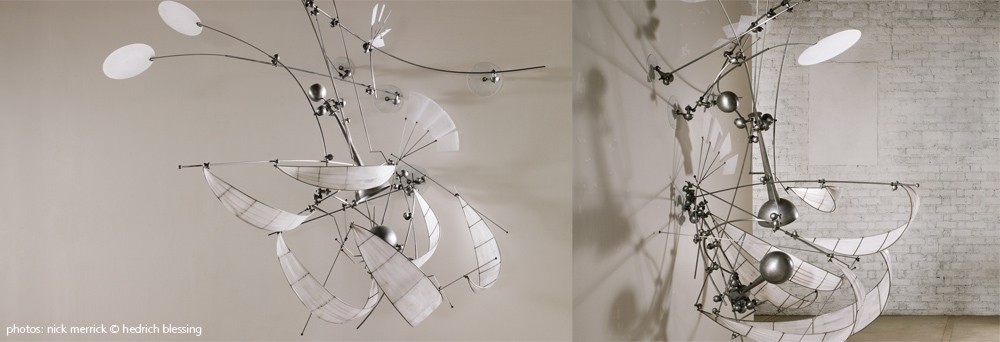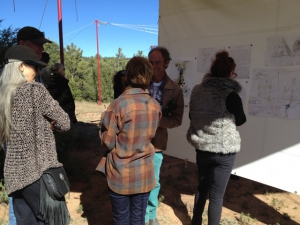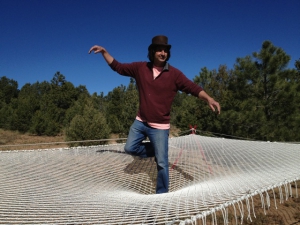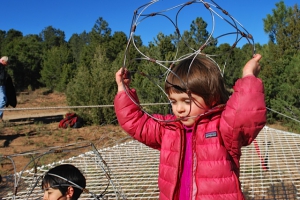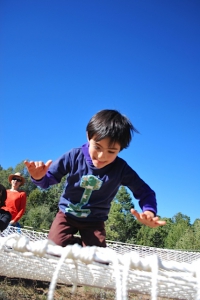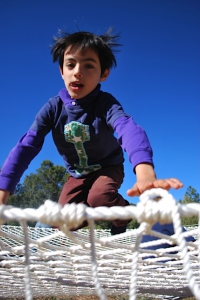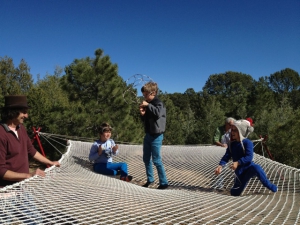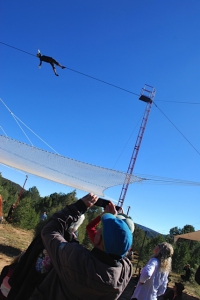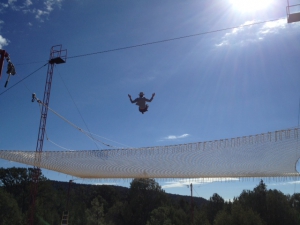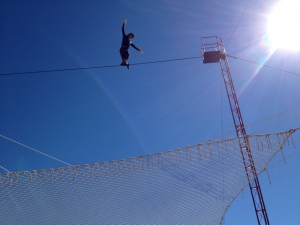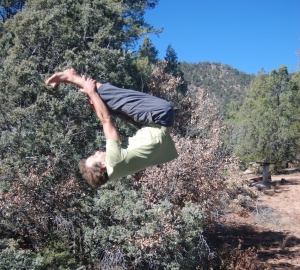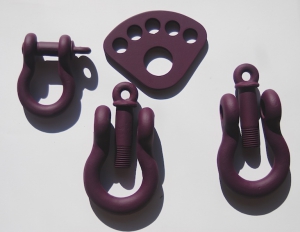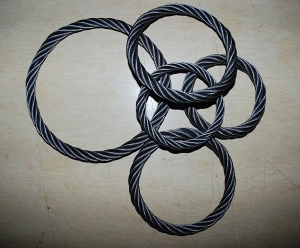Since my last process update I held my first public performance on the high wire. About one hundred people drove out to my land and participated. Even though it was quite windy and I was extremely nervous, I gave three 5- 9 minute performances over the duration of the afternoon. I also set up the small net as a sort of trampoline and a low rope for people to play on if they signed a waiver. The children loved the net and some played on it for hours. I also set up a tarp pavilion in which to display drawings and plans.
http://axleart.com/index/2013_Exhibitions/Pages/Highwire.htm
Most exciting to me was to see that this journey and project which at times I fear to be quite insular and self indulgent has, by being shared, transformed into something which is neither. It has opened and showed potential, by turning into a demonstration in the freedom and joy contained in one’s initiative creating a shared experience of passion. My building of the structure and performance upon it seemed to act synergistically upon participants in the event. The passion and love of the act is felt by the understanding of the tremendous labor which goes into making it possible. The labor involved in the weaving of the net, as I can tell, is understood almost universally. The labor in welding, fabrication, and other processes of construction seems less tangible to the average person, unless they themselves are directly involved in such types of building. The net perhaps is something more intimate, rare and more mystical than the tube steel structure which proliferate urban scenery. Certainly in human history we have a very long and important relationship with ropes, threads, nets, and textiles. I, for one, have a relationship and attraction to rope and line which feels instinctual.
It was amazing how different an act feels with an audience. Right before the public began to arrive I ran through my routine several times and it felt solid and graceful. The turns were crisp and I did not waver with steps or balances. However at the performance as I climbed the towers and prepared to step out on the wire I felt numbed by fear. It was as if my blood had thickened and was causing my limbs to feel hypoxic and clumsy. I took my first step out on the wire and realized that no matter how much I practice in solitude, nothing prepares me for the the very different challenge of giving a live performance. Everything felt new and unstable. My breath and heart felt foreign and I struggled to keep my steps steady. The gusts of wind felt stronger, and indeed they were, at one point my hat was blown off of my head and out of sight into the trees! During the performance I passed through the movements as if in a dream,which over the last year I have worked hard to master.
What made these moments in front of the audience feel so different than the hundreds of others I have spent alone with the wire? I think that it can be reduced to something elemental, the desire to succeed and to repeat past achievements. I wanted to do as well in that moment as I had in the past.
However the beauty and curse of the wire is that it is so thin. One’s balance upon it is too unpredictable to be certain. At best one keeps his center close over the wire using only his arms to destroy the movements of falling. The more one is able to balance with the arms, the steadier the gaze and the rest of the body becomes free to dance. But as soon as one’s balance passes outside of this precise realm, more effort both physically and mentally must be used to stay upon the wire. The vision now fights to maintain its target and the body must act on a combination of instinct, training, and luck. I find myself passing between these two states and slowly with more and more practice I find that fluctuations occur less frequently. I am more often in a state of dynamic stillness on the wire than I used to be. It is like meditation. Through practice over time one begins to gain control over the meanderings of the mind. My equilibrium on the wire is no doubt tied to the tides of my mind.
I have said in the past it is perhaps better not to think at all. I am beginning to realize this statement is too abstract, absolute, and does little justice in regards to the complexity of the situation. The sensation of pressure on flesh is a thought of sorts, so to is our ability to will ourselves in moving our bodies through space. To me this presents a central dilemma in understanding the nature of existence and action. We have thoughts which can be quite removed from reality dreams for example, when our mind invents entire landscapes and situations. We can have delusions where our cognition fails us. We have immense mental constructs which we build over the course of our life allowing us to navigate through time, space, society, and relationships. These feelings and constructs seem as real as anything. Yet time and time again we are reminded that they are imperfect abstractions of a greater more inclusive reality. I will be standing on the wire feeling perfectly balanced and suddenly I am fighting for my balance. What did I miss, when did the feeling/thought of being well balanced pass from a reality to a delusion. Einstein using mathematic as an example spoke of this dilemma.
“At this point an enigma presents itself which in all ages has agitated inquiring minds. How can it be that mathematics, being after all a product of human thought which is independent of experience, is so admirably appropriate to the objects of reality? Is human reason, then, without experience, merely by taking thought, able to fathom the properties of real things?”
Einstein goes on to say the the apparent truths which mathematics reveal are based upon axioms which are true in theoretical environments, but may have little to do with reality itself. For instance between to points a straight line can be defined. We generally think of this as a true statement, a law of nature. But does such a thing as a straight line exist? It would be impossible to achieve with real matter as even a slight influence by gravity causes any material to deflect. Our wonderful and simple explanation becomes exponentially more complex as we leave the world of ideas and enter into reality where everything is warped and curvilinear.
Thus in theory I know that to balance an object is an exercise in geometry. If the object has a base of measurable dimensions, one simply must draw a line from the center of gravity to the center of that base and then point this line like an arrow towards the center of the earth. This is the fundamental building concept of “plumb” which most spectacularly allows us to build towers which reach high into the clouds. Well there are some problems with this. One, if the base is minuscule there will be very little friction between the support and the object. As the earth turns this friction might not be enough to counteract the procession which the object will make as its inertia keeps it still and its support (the earth) rotates. So it may fall even with everything initially balanced perfectly. Now take the complex example of the equilibrist with a multitude of bones and joints allowing all sorts of movement. Articulating and stabilizing these bones and joints are hundreds of muscles orchestrated by a mysterious and elegant electro-magnetic system which acts as commissure between the tangible physical world of body and matter and the intangible spectral world of spirit and energy. Everything is in flux. The muscles tremble and vibrate adjusting under load. Some nerve pathways become pinched by the strain of the muscles affecting proprioception. Then the mind takes what information is available and does its best to interpret, sending waves of electrical signals to orchestrate muscular engagement. Giving all these variables one is never for a moment going to archive a perfect pose of balance, at least in life, perhaps a rigid corpse could achieve static perfection, but then it would rot. Somehow my mind is still fascinated by this potential. It often deludes itself into thinking that I have accomplished it. This notion is the very thing that destroys the grace of the previous moment. The attachment to an abstract projected goal will steal the grace and joy intrinsic in each moment from anyone.
Every man is the sum total of his reactions to experience. As your experiences differ and multiply, you become a different man, and hence your perspective changes. This goes on and on. Every reaction is a learning process; every significant experience alters your perspective.
So it would seem foolish, would it not, to adjust our lives to the demands of a goal we see from a different angle every day? How could we ever hope to accomplish anything other than galloping neurosis?
Hunter S Thompson
The real question is how to maintain a curiosity and a search of love rather than a longing for an accomplishment. To be able to do this while on stage would be a great gift not just to the performer, but to all present. I experienced this recently while attending a Michael Franti and Spearhead concert. I dream of being able to present an experience of that sort of soulful generosity and authenticity. I don’t think artistic contributions of this sort can be designed, or engineered they must be born in a crucible of action, not conducted for profit or popularity, but out of the fascination and love for the act of creation itself.
“A wise man once said that all human activity is a form of play. And the highest form of play is the search for Truth, Beauty and Love. What more is needed? Should there be a ‘meaning’ as well, that will be a bonus?
If we waste time looking for life’s meaning, we may have no time to live — or to play.”
Arthur C. Clark
https://www.dropbox.com/s/j90uqo7mgxfvzmd/trampoline%20wire.mov
https://www.dropbox.com/s/j90uqo7mgxfvzmd/trampoline%20wire.mov
